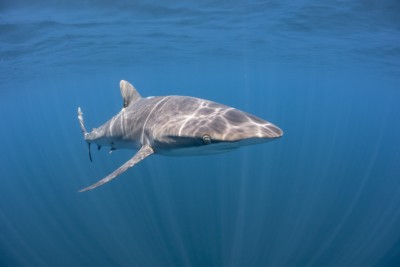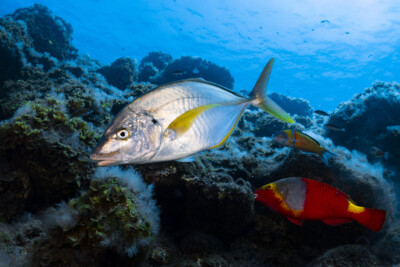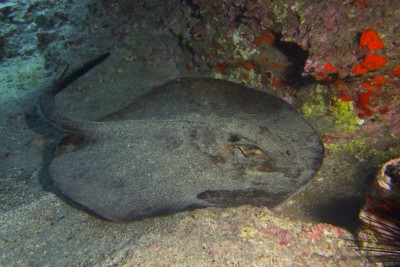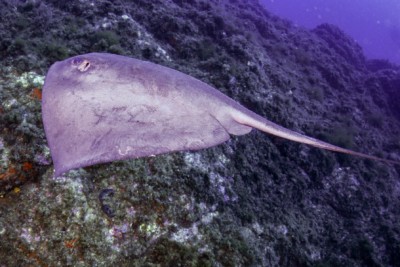roughtail stingray
| Scientific name | Bathytoshia centroura |
|---|---|
| Descriptor | Mitchill |
| Year of description | 1815 |
| IUCN category (World) | VU |
| Family | Dasyatidae |
| Genus | Bathytoshia |


Introduction
The roughtail stingray is a giant among stingrays. The largest individuals exceed 3 meters and 300 kg.
This species frequents the west coast of the Atlantic Ocean, from the southern United States to Argentina. It is also present on the east coast, from Senegal to Spain. It is rare in the Mediterranean, where another species, Bathytoshia lata, is more common.
Who is it?
Morphology
-
Type
-
Average size125 cm
-
Maximum size300 cm
-
ShapeCircular
-
Type
-
Average size125 cm
-
Maximum size300 cm
-
ShapeCircular
How to recognize This fish ?
The eyes are positioned very high on the body and the wide spiracles that allow it to breathe are easily distinguishable. Large specimens have a spiny tail as well as tubercles on the outer parts of the disc.
The very long tail is the same size as the body.
This species can be confused with Dasyatis pastinaca, the common stingray, but the latter does not have protuberances on its back. Juveniles can be confused with Dasyatis tortonesei, but not adults as the latter do not exceed 80 cm.
Sexual dimorphism
Like sharks, stingrays have two pterygopods. These are appendages resulting from the modification of the pelvic fins that allow the transmission of sperm to the female's cloaca. Males can only use one at a time.
Behaviour & Life cycle
-
dietcarnivorous
-
Sociabilitysolitary
-
territorialNo
-
Way of livingdiurnal
This species leads a solitary lifestyle. It frequents coastal sandy bottoms where it spends a large part of the day buried.
It feeds on invertebrates and fish living on the seabed, such as sand eels and gobies.
Camouflaged, it is not afraid of divers and swimmers, making it particularly dangerous. If it feels threatened, it raises its sting and lashes out with its tail to sting the intruder. The sting can sometimes be deadly. Its defense mechanism is reminiscent of a land snake.
It is also dangerous for fishermen who can easily be stung in case of capture.
Reproduction
-
Reproductionovovivipare
This species is ovoviviparous and can have 2 to 4 pups per litter after a gestation period of 4 months. Birth takes place in early winter in the western Atlantic Ocean.
Life-threatening species
-
VenomousYes
This species is highly venomous and can cause serious accidents upon contact. In the most severe cases, it can lead to death.
What to do in the event of a sting?
in case of sting, the following rules should be followed, in this order:
- Isolate the victim from the danger and quickly remove him or her from the water
- Call for help
- Lay the victim down in a half-sitting position and avoid any effort
- Immobilize the affected limb
- Clean the wound
- The venom of this species being thermolabile, it can be neutralized if it is submitted to a temperature of about 45 °C. It is therefore possible to heat the wound. This popular technique should be practiced with great care so as not to aggravate the wound by burning it. It is advisable to immerse the affected limb in hot water.
- If the puncture is too deep, heating the wound will be less effective.
Sometimes the sting can cause discomfort or even loss of consciousness in the victim. The stings are usually very painful.
Origin and distribution

Conservation status of populations (IUCN)
What is its habitat?
Natural environment characteristics
-
Temperature10 - 27 °C
-
Depth15 - 50 m
Biotope presentation
This species favors sandy bottoms. It is more common between 15 and 50 meters, but has been observed from the first meters to depths exceeding 250 meters.
Species of the same biotope
To go further
Sources & Contributions
Participation & Validation
The Fishipedia team and specialist contributors are committed to providing high-quality content. However, although the information comes from scientific sources or testimonials from specialists, the cards may contain inaccuracies.

Adrien Falzon

Benoit Chartrer

Julie Magnus

Silvia Gomez
Translation
Translation done with the valuable contribution of our translators, who make this information available to a wider audience. We sincerely thank them for their commitment.
Bibliographic references
The Rays of the World project – an explanation of nomenclatural decisions - PETER R. LAST - MARCELO R. DE CARVALHO - SHANNON CORRIGAN - GAVIN J.P. NAYLOR - BERNARD SÉRET - LEI YANG - The Rays of the World project - 2016.
Scientific partners
Tags
Species of the same family
Same genus
Species of the same biotope


























